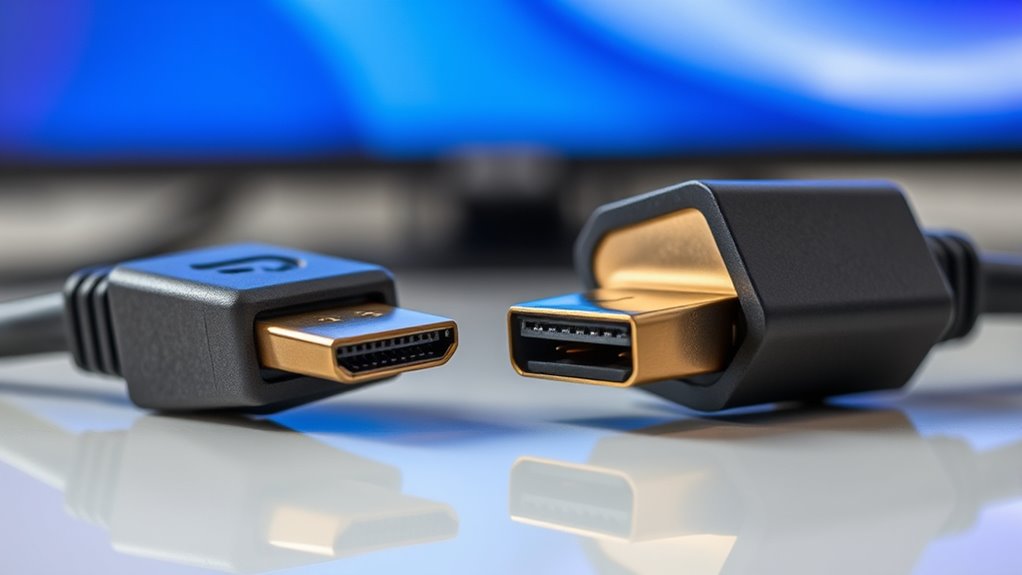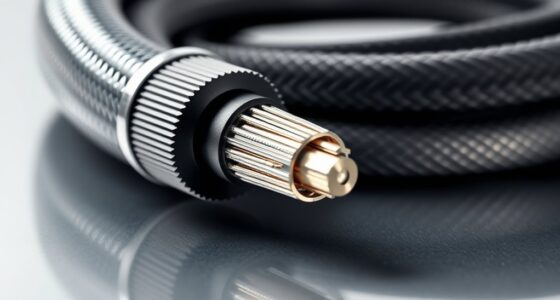If you’re choosing between HDMI and DisplayPort for your monitor, consider your needs. HDMI is more common for entertainment devices and offers good compatibility with TVs and gaming consoles, while DisplayPort provides higher refresh rates, better performance for gaming, and support for multiple high-res monitors. DisplayPort’s locking mechanism also makes it more durable. To find out which cable best suits your setup and future-proofing needs, continue exploring the differences.
Key Takeaways
- DisplayPort offers higher bandwidth and supports higher refresh rates, ideal for gaming and professional high-resolution workflows.
- HDMI is more widely compatible with TVs, gaming consoles, and consumer electronics, making it versatile for entertainment setups.
- DisplayPort features secure locking mechanisms, providing more stable, durable connections over time.
- HDMI supports broad audio formats and device compatibility, especially for media consumption and home entertainment.
- Choose DisplayPort for professional use and high-performance gaming; opt for HDMI for general entertainment and device flexibility.
Understanding HDMI and DisplayPort: An Overview

HDMI and DisplayPort are two common types of digital interfaces used to connect devices like monitors, TVs, and computers. When choosing between them, cable durability and connection stability are key factors. HDMI cables generally offer good durability, but they can sometimes become loose or wear out over time, affecting connection stability. DisplayPort cables tend to be more robust, with secure locking mechanisms that prevent accidental disconnections and enhance stability during use. Both interfaces support high-quality audio and video signals, but DisplayPort often provides better stability for high-bandwidth applications. Additionally, cable longevity can vary based on usage patterns and environmental factors, influencing your choice for specific needs. Considering the connection stability and overall build quality of the cable can ensure a more reliable and long-lasting setup. Understanding these differences helps you select a cable that guarantees a reliable connection and long-lasting performance, whether you’re setting up a home theater or a professional workstation.
Key Features and Capabilities of HDMI
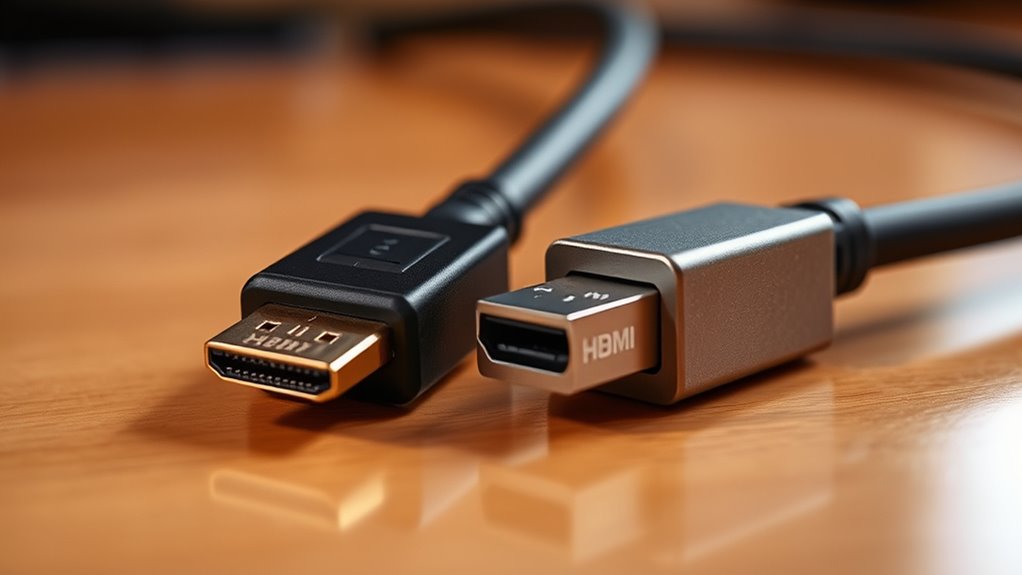
HDMI offers impressive video and audio quality, making it ideal for home entertainment setups. Its compatibility across a wide range of devices guarantees versatility in connecting your gadgets. Understanding these key features helps you choose the right option for your specific needs. Additionally, HDMI supports lifespan perspective that emphasizes continuous growth and adaptation of technology over time. This ongoing development ensures that HDMI remains a reliable and future-proof choice for various multimedia applications. The evolution of HDMI technology aligns with AI in Education, reflecting how innovation can enhance user experiences and expand functionality across different fields.
Video and Audio Quality
When it comes to delivering high-quality video and audio, HDMI stands out with its impressive capabilities. It supports up to 4K and even 8K resolutions, guaranteeing sharp, vibrant images with excellent color accuracy. Audio fidelity is also exceptional, providing clear, immersive sound through various formats like Dolby Atmos. This makes HDMI ideal for both entertainment and professional use. To highlight this, consider the table below:
| Feature | HDMI | DisplayPort | Notes |
|---|---|---|---|
| Max Resolution | 8K at 60Hz | 8K at 60Hz | Both support high resolutions |
| Color Accuracy | High, supports HDR | Similar, supports HDR | Ensures vivid, true-to-life colors |
| Audio Fidelity | Excellent, supports multiple formats | Similar, supports multiple formats | Both provide immersive sound |
| Audio Channels | Up to 32 channels | Up to 8 channels | HDMI handles more audio channels |
| Additional Features | CEC, ARC for better control | Adaptive sync, daisy chaining | HDMI offers more integrated features |
Additionally, HDMI’s compatibility with many devices makes it a versatile choice for various setups. It also supports additional features like Ethernet over HDMI, which can simplify connections. A reliable connection is crucial for maintaining high-quality signals during use. Ensuring a stable signal transfer helps prevent interruptions and maintains optimal audio-visual performance.
Compatibility and Versatility
Because it’s widely adopted across various devices, HDMI offers remarkable compatibility and versatility that make it a preferred choice for many users. You’ll find HDMI cables working seamlessly with TVs, gaming consoles, laptops, and more, thanks to its broad support. The different connector types, like Standard, Mini, and Micro HDMI, allow flexibility for various setups and device sizes. HDMI also tends to be more durable, with sturdy connectors designed to withstand frequent plugging and unplugging. This cable durability ensures long-term reliability, reducing the risk of damage over time. Its widespread compatibility means you don’t need multiple adapters, simplifying your setup. Additionally, HDMI supports digital audio and video transmission, making it an all-in-one solution for multimedia connections. Because HDMI supports high-definition content, it is especially popular for both home entertainment and professional media applications. Overall, HDMI’s versatility makes it ideal for everyday use, connecting a wide range of devices with ease and confidence.
Essential Aspects of DisplayPort Technology
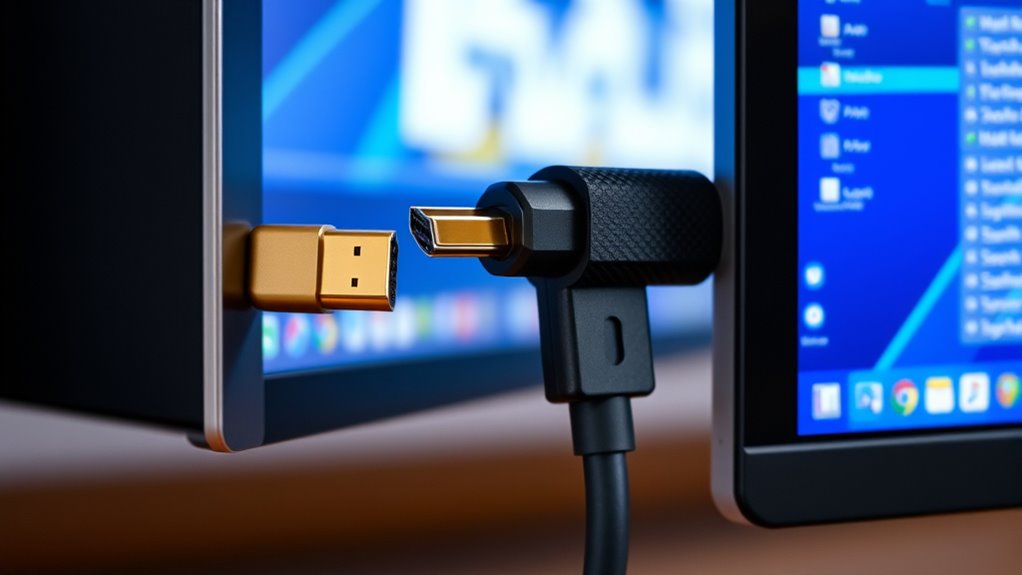
DisplayPort technology offers high bandwidth capabilities that support ultra-high-resolution displays and fast data transfer. It also includes adaptive sync support, which helps eliminate screen tearing for smoother visuals. Understanding these features is key to choosing the right connection for your setup. Incorporating natural elements into the setup can further enhance the visual experience by creating a more calming environment. Additionally, the bandwidth capacity of DisplayPort allows for future-proofing as display technology continues to evolve.
High Bandwidth Capabilities
High bandwidth capabilities are a key factor that set DisplayPort apart, enabling it to handle the demands of modern high-resolution displays and fast refresh rates. With higher bandwidth, you can enjoy smoother visuals and reduced input lag, especially at resolutions like 4K or even 8K. DisplayPort’s ability to transmit large amounts of data means you can run high refresh rates without sacrificing image quality. Additionally, it supports longer cable lengths without losing signal integrity, so you won’t need to worry about degradation over distance. This high bandwidth flexibility makes DisplayPort ideal for gaming, professional work, and setups where high refresh rates are essential. Overall, its capacity to support demanding displays ensures a more seamless, high-performance experience. Proper storage methods can further maintain signal quality during longer cable runs. Moreover, the technology’s bandwidth capabilities allow for future-proofing as display resolutions and refresh rates continue to advance.
Adaptive Sync Support
Adaptive Sync support enhances the viewing experience by dynamically matching a display’s refresh rate to the frame rate of your graphics card. This synchronization minimizes screen tearing, stuttering, and input lag, resulting in smoother gameplay and videos. With DisplayPort’s adaptive sync capabilities, you’ll notice more consistent motion and improved responsiveness. It also helps maintain color accuracy during fast-paced scenes, preserving image quality. Unlike fixed refresh rates, adaptive sync adjusts in real-time, ensuring your monitor’s refresh rate aligns with the content’s frame rate. This feature is especially beneficial for gaming, where seamless visuals matter. Overall, adaptive sync support elevates your display’s performance, offering a more fluid and visually accurate experience, making it a key aspect of DisplayPort technology. Cookies are used to enhance user experience by enabling adaptive features and collecting performance data. Additionally, the integration of on-device AI capabilities in display technology is expected to further optimize adaptive sync performance and user interaction.
Video and Audio Quality Comparison
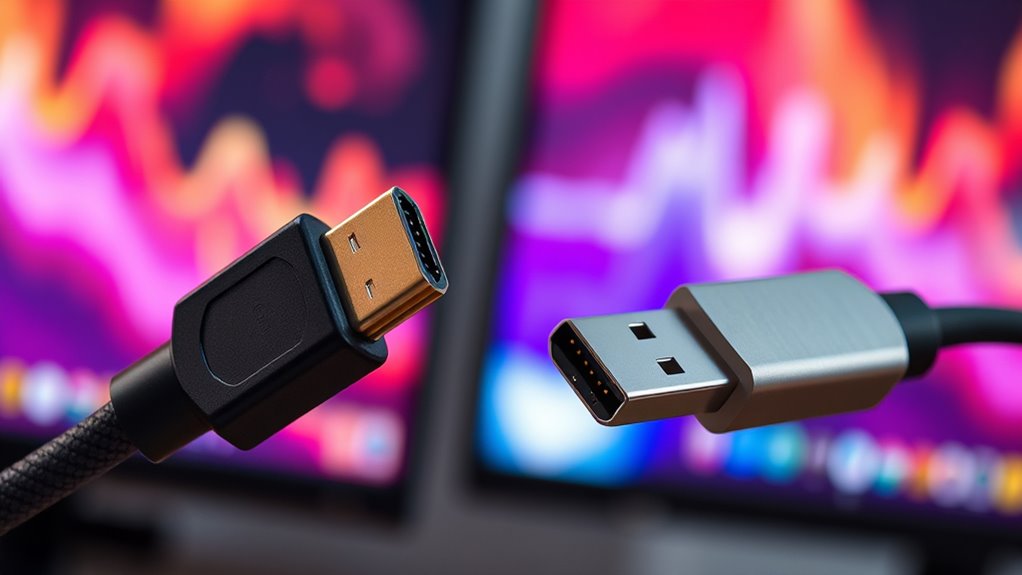
When comparing video and audio quality, it’s clear that both HDMI and DisplayPort deliver impressive performance, but subtle differences can influence your choice. HDMI generally provides excellent color accuracy, making it ideal for media consumption, while DisplayPort often supports higher refresh rates, which benefits gaming and fast-paced visuals. Both cables can transmit high-quality audio, but HDMI has broader compatibility with consumer electronics, ensuring consistent sound delivery. If you prioritize vibrant, true-to-life colors, HDMI might be your best bet. Conversely, if your focus is on ultra-smooth motion with higher refresh rates, DisplayPort’s capabilities could give you an edge. Additionally, understanding connection standards can help you select the most suitable cable for your setup. It’s also worth noting that video bandwidth varies between standards and can affect overall performance. Considering data transmission capabilities is crucial for optimizing your display quality. To maximize your display experience, pay close attention to bandwidth requirements when choosing between these cables. Ultimately, both deliver stellar video and audio, but your specific needs around color fidelity and refresh rate will guide the most suitable choice.
Compatibility and Device Support
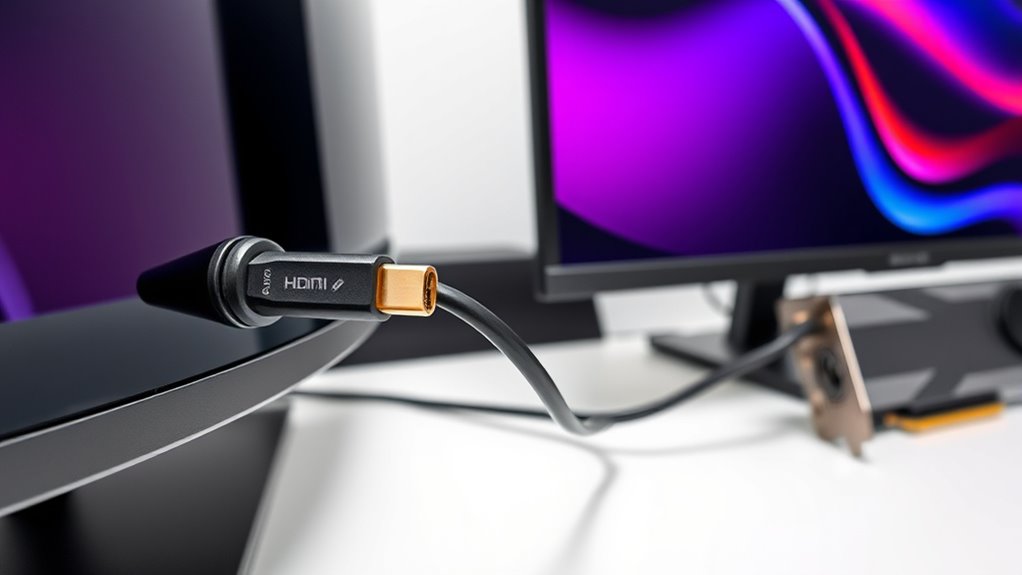
While both HDMI and DisplayPort are widely supported, their device compatibility can vary considerably. HDMI is more common in consumer electronics like TVs, gaming consoles, and Blu-ray players, making it easier to connect to a variety of devices. DisplayPort, on the other hand, is primarily found in PCs and high-end monitors, often supporting higher resolutions and refresh rates. When choosing a cable, consider durability; HDMI cables tend to be more robust for everyday use, while DisplayPort cables are designed for high-performance setups. Additionally, color accuracy can differ, especially at higher resolutions, with DisplayPort generally offering better support for precise color reproduction. Ensuring compatibility with your devices helps avoid connection issues and guarantees ideal performance. device compatibility plays a crucial role in selecting the right cable for your setup. Moreover, understanding standard support and features like audio transmission can further influence your choice.
Use Cases and Performance in Different Scenarios
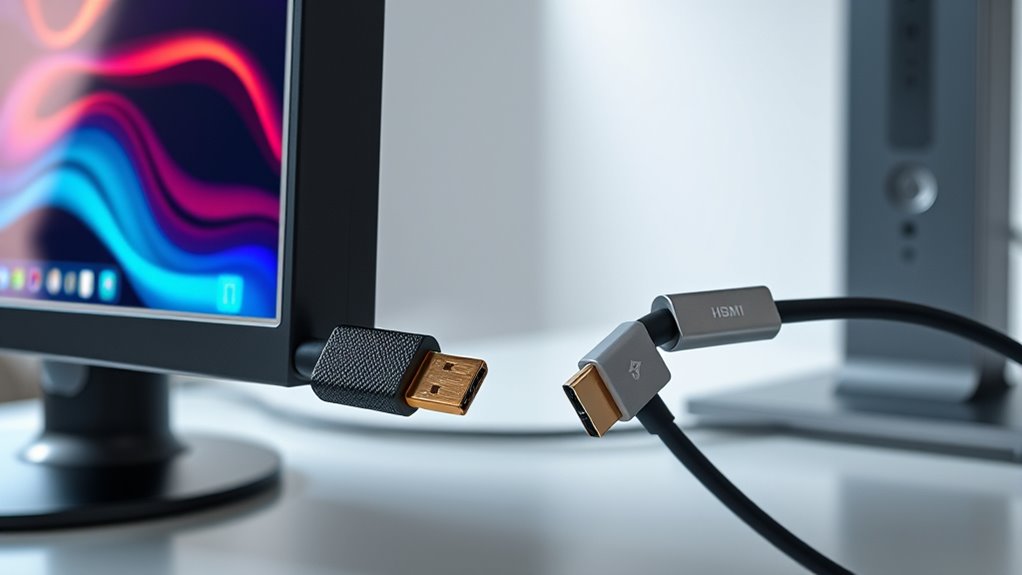
The choice between HDMI and DisplayPort often depends on the specific use case and performance requirements. For gaming performance, DisplayPort generally offers higher refresh rates and better support for adaptive sync technologies like G-Sync and FreeSync, making it ideal for smooth gameplay. If you’re working with professional workflows, such as video editing or graphic design, DisplayPort’s higher bandwidth allows for multiple high-resolution monitors and faster data transfer. HDMI, on the other hand, is more common for media consumption, supporting popular formats and easier device compatibility. Depending on whether you prioritize gaming performance or professional multitasking, selecting the right cable can considerably enhance your experience and productivity.
Making the Right Choice for Your Monitor Setup
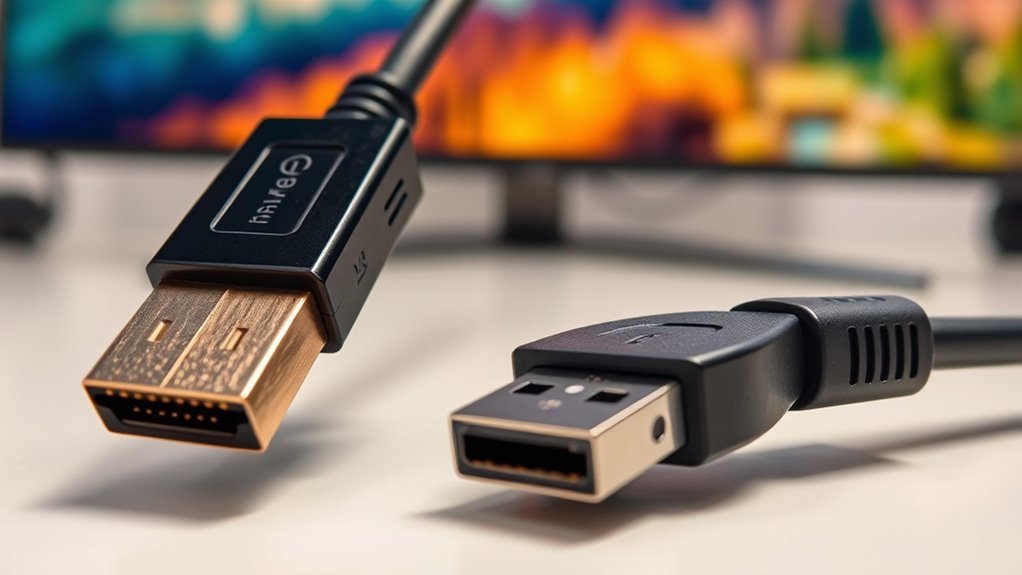
Choosing the right monitor connection depends on your specific needs and setup, as both HDMI and DisplayPort have unique advantages. To make an informed decision, consider these factors:
- Cable durability: If you move your setup frequently, opt for a cable with reinforced connectors and quality materials to avoid wear and tear.
- Color accuracy: For professional work or content creation, prioritize a connection that supports higher color fidelity, often found in DisplayPort.
- Compatibility: Ensure your monitor, graphics card, and other devices support your chosen cable to prevent connection issues and maximize performance.
Frequently Asked Questions
Which Cable Is More Future-Proof for Upcoming Monitor Technology?
You should choose DisplayPort for better future compatibility with upcoming standards. It’s more adaptable to future monitor technology because it supports higher refresh rates, increased bandwidth, and newer features like USB-C integration. HDMI is still evolving, but DisplayPort’s ongoing updates and higher version support make it a smarter choice if you want a cable that’ll stay relevant as monitor specs improve. Your setup will be more ready for future upgrades.
Can HDMI or Displayport Cables Support 8K Resolution?
Like a bridge connecting worlds, HDMI and DisplayPort can support 8K resolution, but with differences. DisplayPort 1.4 and HDMI 2.1 offer the best compatibility for 8K, handling high bandwidths needed. You’ll need the right version and compatible cables, so check your monitor and device specs. While both can support 8K, DisplayPort generally offers more reliable resolution support for high-end setups.
Are There Differences in Cable Length Limitations Between HDMI and Displayport?
You’ll find that HDMI cables typically support longer runs, up to 50 feet, with some active cables, while DisplayPort cables generally perform best under 15 feet for ideal signal quality. When considering cable durability and connector compatibility, choose high-quality options to prevent degradation over longer distances. Both cables have sturdy connectors, but verify compatibility with your devices to avoid connection issues, and always opt for cables rated for your desired resolution and refresh rate.
Do HDMI and Displayport Cables Differ in Power Delivery Capabilities?
You’ll find that HDMI and DisplayPort cables differ in power transmission capabilities, with DisplayPort generally providing slightly better power delivery for connected devices. This can help reduce the need for extra power sources. Additionally, both cables vary in cable durability; high-quality versions offer better shielding and build, ensuring longer-lasting connections. Choosing a durable cable with strong power transmission can improve your monitor setup’s overall stability and longevity.
Is There a Noticeable Difference in Latency When Using HDMI Versus Displayport?
While you might not notice a huge difference in signal latency between HDMI and DisplayPort, DisplayPort often offers slightly better performance for gaming. You’ll experience minimal lag, which can enhance your gaming performance, especially with high-refresh-rate monitors. HDMI usually handles casual gaming well, but if you’re after top-tier responsiveness, DisplayPort’s lower latency gives it a subtle edge. Ultimately, both are excellent choices, with slight differences for serious gamers.
Conclusion
Choosing between HDMI and DisplayPort isn’t just about specs—it’s about finding the connection that best aligns with your needs. While one might seem more suited today, the true harmony lies in understanding your setup and future plans. Sometimes, the subtle differences whisper possibilities you hadn’t considered. Trust your instincts and select the cable that invites your monitor to reach its full potential, quietly guiding you toward a more seamless experience.
